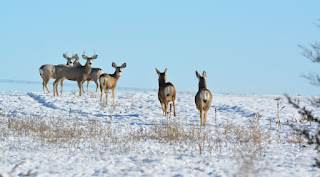This week Nevada Outdoor School welcomes guest writer Sierra Sampson. Sierra is a Northeast Zone Botanist for the Humboldt-Toiyabe National Forest, United States Forest Service. Nevada Outdoor School loves to partner with federal and state agencies to further our message of responsible outdoor recreation and outdoor education. Sierra and our Winnemucca location worked with the Paradise Valley School last summer to plant a butterfly garden. We look forward to working with Sierra again!
Winter ecology is “the basic relationship between organisms and their environment during the winter season.” The short days and long nights of winter bring unique challenges to the Nevada mountains and the plants, animals and insects, including cold, radiation, energy, wind and snow. If animals can manage this list of difficulties, they can “C.R.E.W.S.” through winter. There are typically three options: adapt, migrate or die.
Animals use numerous different tactics to make it through the cold months. Some hibernate, going into a dormant state to save energy. Different species of birds, such as chickadees and nuthatches, will huddle together for warmth. Small animals burrow in the subnivean zone below the snow surface, which offers them warmer temperatures and protection from harsh weather and predators.
A chickadee puffing its feathers for more insulation
Many Nevada species migrate to lower elevations and milder temperatures during winter months. Some species, like the monarch butterfly and the Indigo Bunting migrate thousands of miles to warmer areas of Mexico. Mule deer, Elk, and Pronghorn also move down to lower elevations in search of warmer temperatures and easier food to forage.
Mule Deer moving lower down in elevation for the winter
Imagine preparing for a ski or snowshoe trek in the forest. Since we don’t naturally grow a winter coat, we can bundle up in warm layers that allow us to adjust to temperature fluctuations throughout the day. Rather than burrowing below the snow or curling up in dens, we use tents as shelter for winter camping. Many animals prepare for the winter by eating more or stashing food during the fall; we tap into a relatively reliable food supply (the local grocery store) to find fuel year-round. Finally, while some animals have adaptations that help them clear snow (think hooves) or travel on top of it (like the Jackrabbit, whose large paddle like feet serve as natural snowshoes), we rely on tools such as shovels and skis to navigate the winter environment.
Jackrabbit starting to develop its winter coat
Plan ahead and prepare -- layer up to bundle up and get out there this winter to experience the fresh air and sunshine…and maybe you will catch a glimpse of an animal and how it is C.R.E.W.S.ing through winter. Get outside, it’s good for humans everywhere!



